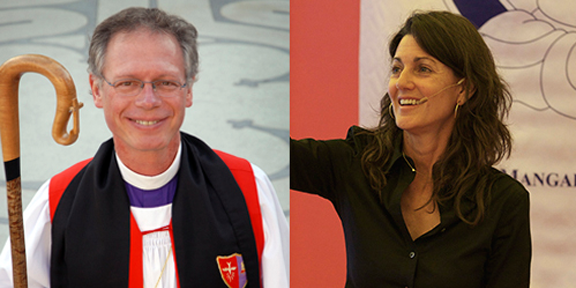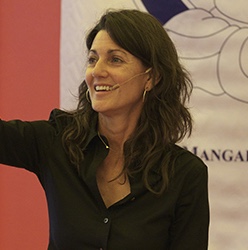


It may be uncommon to associate environmentalism with religion, but Bishop Marc Andrus is looking to change that. More importantly Andrus, Bishop of the Episcopal Diocese of California, is looking to open a larger dialogue about communal responsibility in the modern world. He was also one of the first official delegates from the Episcopal Church to attend the United Nations Climate Change Convention in Paris in 2015.
Andrus and Buddhist teacher Elizabeth Mattis-Namgyel met on stage at the Rubin Museum to discuss the intersection of spirituality and global challenges like climate change.
In preparation for their full discussion, they answered a few questions on faith, misconceptions about their spiritual communities, and the state of the universe:
The Rubin’s conversation series is based around the idea of karma and its various interpretations. What does karma mean to you?
Bishop Marc Andrus: Karma means that justice is woven into the fabric of the universe. As the Rev. Martin Luther King Jr. is often quoted: “The arc of the moral universe is long, but it bends towards justice.” The new cosmology, the understanding of the unfolding of the space/time continuum from the moment of the Great Flaring Forth, helps us understand the ancient wisdom of a moral universe better. We are beginning to reclaim the understanding that consciousness and love are not latecomers on the scene of cosmic history but were here from the beginning (and I would say, from before the beginning).
Elizabeth Mattis-Namgyel: Karma, in the context of Buddhist wisdom, simply means “activity.” Specifically it is the activity of interdependence, where every action has a reaction, a cause and effect. Karma is a neutral term. It doesn’t have a built in sense of justice or some kind of central organizing principle or director. And yet we see the efficacy and order of cause and effect in our everyday lives. How we navigate this in a way that brings happiness and freedom from suffering—that’s the question!
In your opinion, what is the biggest misconception about your spiritual community?
BMA: Here in the United States, Episcopalians have been called “God’s frozen chosen,” meaning we are emotionally limited and materially prosperous, an Anglo tribal religion. To whatever degree this characterization was true, the current reality is much different—we are multicultural, of many different economic statuses, and deeply engaged in the work of justice. We have been at the forefront of work on racial reconciliation, migration justice, eco-justice, LGBTQ work, and recognition of the rights of women, to name some of the prominent struggles we’re part of. For instance, the oldest bishop of the worldwide Anglican Communion (the Episcopal Church is a part of this body) lives in our diocese—he just turned 101. He was in the front line of the Selma to Montgomery to March in 1965. We’ve been keeping on, following his lead. I wore his Episcopal ring in the People’s Climate March in New York City.
EM-N: I think people often see Buddhism as socially passive. Many of the great Buddhist masters have left worldly life and gone into caves or forests to meditate. Those who live on the isolated plateaus of Tibet, probably even now, don’t think much about climate change. However, solitary retreat practice comprises only part of the Buddhist tradition. In fact Mahayana Buddhist practice solely focuses on the suffering of others. Its main idea is that of bodhicitta or “awakened heart,” where one focuses their life on the cultivation of altruism with the inspiration to continue moving away from self-centeredness and toward the wellbeing of others. The view and path is realistic, radical, and deeply transformative but it’s not a crusade to do good or save the world, because one also never departs from the wisdom that you can’t bring the world to a state of peaceful equilibrium—life is too dynamic for that.
How does your faith or spiritual philosophy influence the way you perceive global climate change and other societal problems?
BMA: We love the Earth because God made it and it reflects and bears the divine beauty. It all comes from Midnight Mass. One thing about the Episcopal Church that thousands upon thousands of non-Episcopalians have directly experienced is Midnight Mass on Christmas Eve. We go all-out for Midnight Mass: sublime music, candles, processions, and the giddy experience of being in church for a long stretch and then walking out into the wee hours of Christmas day.
We Episcopalians pour so much into this service because we really love the God-made-human part of the whole sweep of Christian believing. That this peasant child contained the fullness of Divine Being is thrilling, and affects how we see everything that unrolls from that tiny life’s beginning.
Because of our love for the incarnation of God, we love all that God made, all the world. We have many committed people working tirelessly and joyously on climate change. In our own Diocese of California (which is really the Bay Area) we have the Rev. Canon Sally Bingham, one of the most famous climate change activists in the world; Tom Steyer, Grace Cathedral trustee and denizen of the pages of the New York Times for throwing his energy and his money into climate change causes on the political front; the Very Rev. Mark Richardson, dean of the Episcopal seminary in Berkeley, who is a specialist on evolution and Christian theology; the Bishop of California (me), one of the first official delegates from the whole Episcopal Church to one of the UN Climate Change Summits (the Paris summit, in December 2015); the Rev. Joshua Griffin, a PhD student in climate change studies, working closely with the Kivalina indigenous community in Alaska, who must leave their ancestral home due to rising ocean levels; and many more.
EM-N: At the very core of Buddhist spiritual practice lies the wisdom of interdependence. The Buddha said: “This being, that becomes; from the arising of this, that arises; this not being, that becomes not; from the ceasing of this, that ceases.” What this means is that we are a part of the great nature of infinite contingency and so everything we do matters. And yet paradoxically it also means that we are not in total command and only see a little piece of things.
The Buddhist approach is more of an inquiry than a philosophy that encourages we look directly and realistically at who we are in relationship to our world. The purpose is to live in the heart of this beautiful paradox; to develop the capacity to bear witness to the pain and beauty of the world without shutting down and while trying with all our might to ease the suffering we see around us. This includes the suffering of our magnificent planet.

Bishop Marc Andrus is the eighth bishop of the Episcopal Diocese of California. He was installed as bishop in 2006, a position of oversight for a diocese comprising twenty-seven thousand communicants. His leadership has focused on key issues related to peace and justice, including immigration reform, climate change, civil rights for LGBTQ+ persons, racial reconciliation, and health care. An example of his local engagement includes cochairing a community-wide planning process for rebuilding St. Luke’s Hospital in San Francisco. Prior to his election as Bishop of California, Andrus served as Bishop Suffragan in the Episcopal Diocese of Alabama. Bishop Andrus is a member of the We Are Still In Leaders’ Circle, a diverse group of ambassadors for American climate action.

Elizabeth Mattis Namgyel has studied and practiced Buddhism for thirty years under the guidance of her teacher and husband Dzigar Kongtrul Rinpoche. Mattis Namgyel is known for her willingness to question precepts in order to reach a place of genuine practice and awakening. She asks audiences to engage in the practice of open questioning while she takes a fresh look at all of their assumptions and beliefs about spirituality. She is the author of The Power of an Open Question and The Logic of Faith.
Get the latest news and stories from the Rubin, plus occasional information on how to support our work.